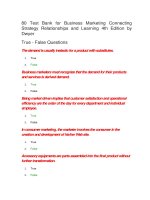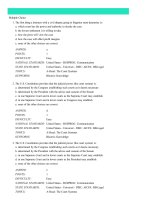Test bank for wongs nursing care of infants and children 9th edition hockenberry
Bạn đang xem bản rút gọn của tài liệu. Xem và tải ngay bản đầy đủ của tài liệu tại đây (50.37 KB, 5 trang )
buy this full document at
Hockenberry: Wong's Nursing Care of Infants and Children, 9th Edition
Chapter 01: Perspectives of Pediatric Nursing
Test Bank
MULTIPLE CHOICE
1. From a worldwide perspective in reducing infant mortality, the United States:
a. is ranked similar to 20 other developed countries.
b. is ranked highest among 27 other industrialized countries.
c. is ranked last among 27 countries that have a population of at least 25 million.
d. is ranked in the middle of 20 other developed countries.
ANS: C
Although the death rate has decreased, the United States still ranks last in infant mortality among
nations with a population of at least 25 million. The United States has the highest infant death
rate of developed nations.
DIF: Cognitive Level: Knowledge
TOP: Nursing Process: Assessment
REF: p. 7
MSC: Client Needs: Health Promotion and Maintenance
2. Which of the following is the leading cause of death in infants younger than 1 year?
a. Congenital anomalies
b. Sudden infant death syndrome
c. Disorders related to short gestation and low birth weight
d. Maternal complications specific to the perinatal period
ANS: A
Congenital anomalies account for 20.1% of deaths in infants younger than 1 year, compared with
sudden infant death syndrome, which accounts for 8.2%; disorders related to short gestation and
unspecified low birth weight, which account for 16.5%; and maternal complications such as
infections specific to the perinatal period, which account for 6.1% of deaths in infants under 1
year of age.
DIF: Cognitive Level: Knowledge
REF: p. 7
MSC: Client Needs: Health Promotion and Maintenance
TOP: Nursing Process: Planning
3. The major cause of death for children older than 1 year is which of the following?
a. Childhood cancer
b. Unintentional injuries
c. Heart disease
d. Congenital anomalies
ANS: B
buy this full document at
Full file at />Unintentional injuries (accidents) are the leading cause of death after age 1 year through
adolescence. The leading cause of death for those younger than 1 year is congenital anomalies,
and childhood cancers and heart disease cause a significantly lower percentage of deaths in
children older than 1 year of age.
DIF: Cognitive Level: Comprehension
REF: p. 3
MSC: Client Needs: Health Promotion and Maintenance
TOP: Nursing Process: Planning
4. In addition to injuries, which of the following are leading causes of death in adolescents and
young adults ages 15 to 24 years?
a. Suicide, cancer
b. Suicide, homicide
c. Homicide, heart disease
d. Drowning, cancer
ANS: B
Homicide and suicide account for 16.7% of deaths in this age-group. Suicide and cancer account
for 10.9% of deaths, and cancer accounts for 3.5% of the deaths in this age-group. Drowning is
responsible for less than 2% of the deaths in adolescents.
DIF: Cognitive Level: Knowledge
REF: p. 8
MSC: Client Needs: Health Promotion and Maintenance
TOP: Nursing Process: Planning
5. Which of the following is descriptive of deaths caused by injuries?
a. More deaths occur in males.
b. More deaths occur in females.
c. The pattern of deaths does not vary widely among different ethnic groups.
d. The pattern of deaths does not vary according to age and sex.
ANS: A
The majority of deaths from unintentional injuries occur in males. The pattern of death does vary
greatly among different ethnic groups, and the causes of unintentional deaths vary with age and
gender.
DIF: Cognitive Level: Comprehension
REF: pp. 3,4
MSC: Client Needs: Health Promotion and Maintenance
TOP: Nursing Process: Planning
6. Morbidity statistics describe which of the following?
a. Disease occurring regularly within a geographic location
b. The number of individuals who have died over a specific period
c. The prevalence of specific illness in the population at a particular time
d. Disease occurring in more than the number of expected cases in a community
ANS: C
Morbidity statistics show the prevalence of specific illness in the population at a particular time.
Data regarding disease within a geographic region, or in greater than expected numbers in a
community, may be extrapolated from analysis of the morbidity statistics. Mortality statistics
refer to the number of individuals who have died over a specific period.
Copyright © 2011, 2007, 2003, 1999 by Mosby, Inc., an affiliate of Elsevier Inc.
Full file at />DIF: Cognitive Level: Knowledge
REF: p. 8
MSC: Client Needs: Health Promotion and Maintenance
TOP: Nursing Process: Planning
7. Which of the following was created in 1965 under Title XIX of the Social Security Act?
a. Medicaid
b. Child welfare services
c. Aid to Families with Dependent Children
d. Maternal Child Health Services Block Grants
ANS: A
Medicaid was created in 1965 to reduce financial barriers to health care for the poor. It is the
largest maternal-child health program. Child welfare services began with Title V in 1930, and
Aid to Families with Dependent Children was enacted in 1935 as a cash grant program to states.
Maternal Child Health Services Block Grants provide services to mothers and children with low
income or limited access to health services.
DIF: Cognitive Level: Knowledge
REF: p. 10
MSC: Client Needs: Health Promotion and Maintenance
TOP: Nursing Process: Planning
8. Which of the following is most descriptive of family-centered care?
a. Reduces effect of cultural diversity on the family
b. Encourages family dependence on health care system
c. Recognizes that the family is the constant in a child’s life
d. Avoids expecting families to be part of the decision-making process
ANS: C
The three key components of family-centered care are respect, collaboration, and support.
Family-centered care recognizes the family as the constant in the child’s life. The family should
be enabled and empowered to work with the health care system and is expected to be part of the
decision-making process. The nurse should also support the family’s cultural diversity, not
reduce its effect.
DIF: Cognitive Level: Comprehension
TOP: Nursing Process: Implementation
REF: p. 11
MSC: Client Needs: Health Promotion and Maintenance
9. Which of the following is most descriptive of critical thinking?
a. Purposeful and goal directed
b. A simple developmental process
c. Based on deliberate and irrational thought
d. Assists individuals in guessing what is most appropriate
ANS: A
Critical thinking is a complex developmental process based on rational and deliberate thought.
When thinking is clear, precise, accurate, relevant, consistent, and fair, a logical connection
develops between the elements of thought and the problem at hand.
DIF: Cognitive Level: Comprehension
REF: p. 15
TOP: Nursing Process: Planning
MSC: Client Needs: Safe and Effective Care Environment: Management of Care
Copyright © 2011, 2007, 2003, 1999 by Mosby, Inc., an affiliate of Elsevier Inc.
Full file at />10. Evidence-based practice (EBP), a decision-making model, is best described as:
a. using information in textbooks to guide care.
b. combining knowledge with clinical experience and intuition.
c. using a professional code of ethics as a means for decision making.
d. gathering all evidence that applies to the child’s health and family situation.
ANS: B
EBP helps focus on measurable outcomes; the use of demonstrated, effective interventions; and
questioning what is the best approach. EBP involves decision making based on data, not all
evidence on a particular situation, and involves the latest available data. Nurses can use
textbooks to determine areas of concern and potential involvement.
DIF: Cognitive Level: Knowledge
REF: p. 14
TOP: Nursing Process: Planning
MSC: Client Needs: Safe and Effective Care Environment: Management of Care
11. Which of the following best describes signs and symptoms as part of a nursing diagnosis?
a. Description of potential risk factors
b. Identification of actual health problems
c. Human response to state of illness or health
d. Cues and clusters derived from patient assessment
ANS: D
Signs and symptoms are the cues and clusters of defining characteristics that are derived from a
patient assessment and indicate actual health problems. The first part of the nursing diagnosis is
the problem statement, also known as the human response to the state of illness or health. The
identification of actual health problems may be part of the medical diagnosis. The nursing
diagnosis is based on the human response to these problems. The human response is therefore a
component of the nursing diagnostic statement. Potential risk factors are used to identify nursing
care needs to avoid the development of an actual health problem when a potential one exists.
DIF: Cognitive Level: Comprehension
REF: p. 16
TOP: Integrated Process: Communication and Documentation
MSC: Client Needs: Safe and Effective Care Environment: Management of Care
12. The nurse is talking to a group of parents of school-age children at an after-school program about
childhood health problems. Which of the following statements should the nurse include in the
teaching?
a. Childhood obesity is the most common nutritional problem among children.
b. Immunizations rates are the same among children of different races and ethnicity.
c. Dental caries is not a problem commonly seen in children since the introduction of
fluoridated water.
d. Mental health problems are typically not seen in school-age children but may be
diagnosed in adolescents.
ANS: A
Copyright © 2011, 2007, 2003, 1999 by Mosby, Inc., an affiliate of Elsevier Inc.
Full file at />When teaching parents of school-age children about childhood health problems, the nurse should
include information about childhood obesity because it is the most common problem among
children and is associated with type 2 diabetes. Teaching parents about ways to prevent obesity is
important to include in teaching. Immunization rates differ depending on the child’s race and
ethnicity; dental caries continues to be a common chronic disease in childhood; and mental
health problems are seen in children as young as school-age, not just in adolescents.
DIF: Cognitive Level: Application
REF: p. 3
MSC: Client Needs: Health Promotion and Maintenance
TOP: Nursing Process: Planning
MULTIPLE RESPONSE
1. Which of the following responsibilities are included in the pediatric nurse’s promotion of the
health and well-being of children? Select all that apply.
a. Establishing a therapeutic relationship
b. Promoting disease prevention
c. Providing support and counseling
d. Establishing life-long friendships
e. Providing financial assistance
f. Participating in ethical decision making
ANS: A, B, C, F
The pediatric nurse’s role includes establishing a therapeutic relationship, promoting disease
prevention, providing support and counseling, and participating in ethical decision making; a
pediatric nurse does not need to establish life-long friendships or provide financial assistance to
children and their families. Boundaries should be set and clear.
DIF: Cognitive Level: Application
REF: p. 18
MSC: Client Needs: Health Promotion and Maintenance
TOP: Nursing Process: Planning
Copyright © 2011, 2007, 2003, 1999 by Mosby, Inc., an affiliate of Elsevier Inc.









